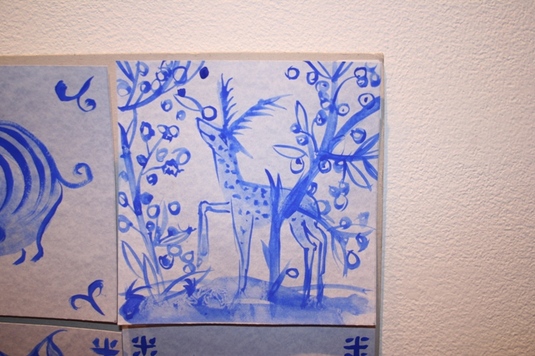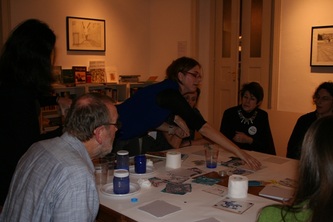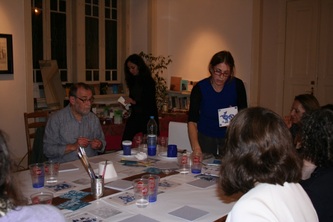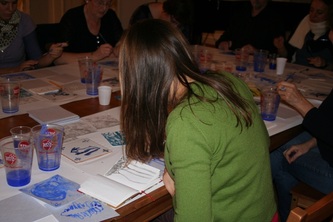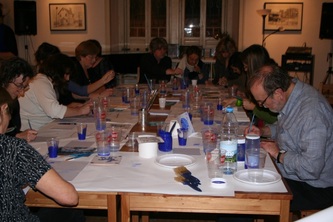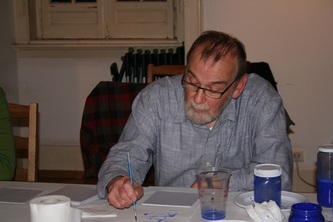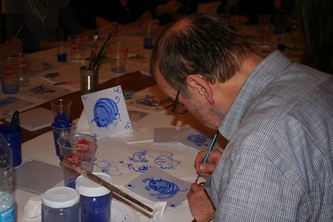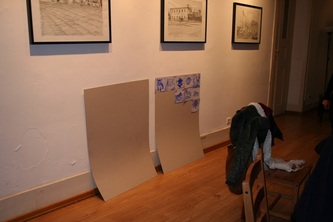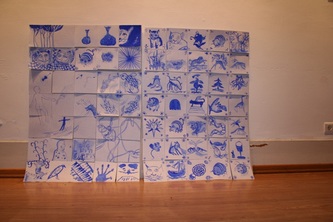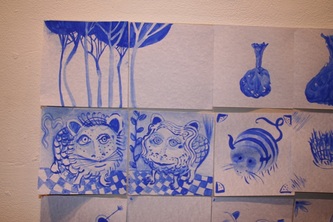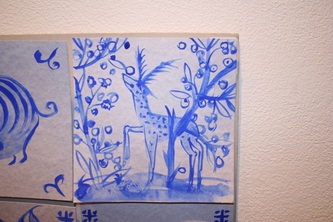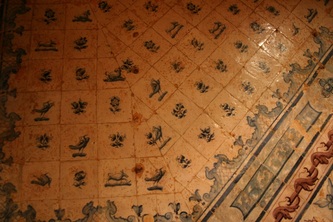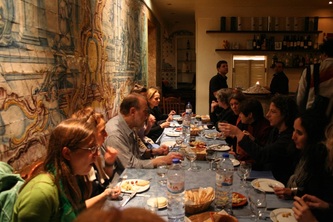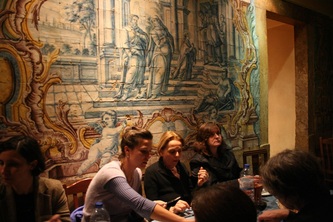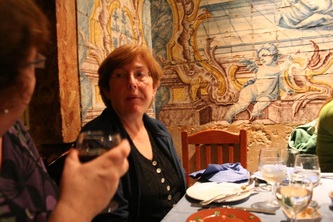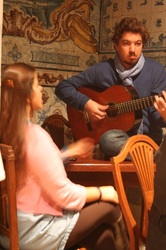_© All rigths reserved to Associação Espaços do
Desenho-Drawing Spaces. Text.Sound.Video.Images
_ Drawing BLUE TILES with traditional techniques
Following the portuguese tradition of tile painting
in the XVII and XVIII centuries
Drawingspaces, Fábrica Braço de Prata
Lisbon, Portugal
19 NOVEMBER 2011
Following the portuguese tradition of tile painting
in the XVII and XVIII centuries
Drawingspaces, Fábrica Braço de Prata
Lisbon, Portugal
19 NOVEMBER 2011
REPORT 6 -
IDEAL
Intercultural Drawing for European Adult Learning
Intercultural Drawing for European Adult Learning
WHAT
A Drawing workshop based on Portuguese Tiles.
WHERE
DrawingSpaces, Fábrica de Braço de Prata, Lisbon, Portugal.
WHEN
19 November 2011, 18h – 21h
WHO
Facilitators and Staff
Staff - Guida Casella
Facilitator - Teresa Carneiro
Facilitator - Marta Carneiro
Adult learners
18 adults, male and female
This workshop was organized for IDEAL partners as part of a Mobility Meeting in Lisbon.
WHY
This activity had the purpose to provide the participants - IDEAL partners - the opportunity to experience some Portuguese Heritage through Drawing. More concretely, it enabled participants to experience the traditions and imagery of Portuguese tiles by working with some of its techniques and with reference to its imagery.
The workshop was meant to be developed after a visit to the Museu Nacional do Azulejo (Tiles National Museum in Lisbon, Portugal). This visit had nevertheless to be cancelled given to the NATO Summit that took place in Lisbon during the same period and which limited the circulation of public transportations and access to various areas of Lisbon. Nonetheless, some partners managed to visit the Tiles National Museum the morning after the workshop day.
During this activity it was also provided a brief input on the History of Tiles and on the context of Portuguese Tile work. Nevertheless, the workshop was more focused on giving an opportunity to the participants to explore more intuitively – through making - some tiles imagery and its techniques.
HOW
This activity was developed in the meeting room that Drawingspaces organized for the IDEAL Meeting, at Fábrica do Braço de Prata.
Previous to the workshop a table was prepared with:
· Brushes
· Blue ink in 3 different tones
· 15x15cm squares of paper
· 15x15cm squares of prints of actual tile photographs (printed to scale)
· Plastic glasses to mix the ink and water
· White tissues for drying and controlling the ink flow
Several books and images were also provided showing both 18th century traditional tile painting and works of contemporary Portuguese artists that use tile painting through contemporary approaches.
1. To begin with, the facilitator provided a brief context for the drawing activity, namely referring that:
a. Portugal has a great historical tradition of tile painting.
b. Several historical tiles that arrived to our days are still extremely well preserved, allowing the study of its traditions and context, as well as the appreciation of its aesthetics.
c. It is rather important to recognize the drawing inherent in tile paintings, as drawing as traditionally been the basis for this practice.
2. After, some important characteristics of tile painting were introduced:
a. The use of loose lines
b. The use of 3 shades of blue
c. The centring of a figure inside the square shape of the tile
d. Some main themes in tile work: animals, plants, human figure.
Given their explicit use of ink layers, Portuguese blue and white tiles were chosen as good examples for studying the qualities of drawing inherent in tile painting.
Blue ink, applied with different types of brush in 3 washes of different densities over the white tiles, has been traditionally used to give expression and volume to imagery – usually animals, plants or human figures.
This activity was explained to the participants in terms of a simple analogical drawing.
3. After this introduction, the participants were asked to copy into a white 15cm x 15cm square of paper a chosen printed image from the examples provided by the facilitators (printed from photographs of historical tiles). The participant had several squares of paper and different brushes at hand to be able to experiment freely the movement of their hands as they were studying the loose lines of the imagery. Different dilutions of blue ink were also provided to the participant who could also add water into the ink to try out new washes. When the participant felt comfortable enough with an image he could also make new drawings and experiments based in different imagery. The objective was to use drawing as a way of understanding and exploring how this particular way of tile painting was made.
4. After working with reference to these printed reproductions the participants were more experienced and comfortable with these techniques and had better control on its possible effects. In this way, on a second stage of this activity the participants were asked to make their own drawings using some of the explored and learned characteristics of tile painting. Participants used several 15cm x 15 cm squares of paper to create their own drawing.
5. During the second half of the activity, the facilitators started displaying the square tiles created by the participants, gathering them as a unique piece, in the shape of a panel (please see images of the workshop). In this way, each drawing became an integral part of collective tile panel, integrating traditional imagery together with contemporary imagery. At the end of the project, the tile panel was offered to the Director of Fabrica Braço de Prata, Nuno Nabais, to be displayed in this big cultural space. This was also a way of thanking Fábrica Braço de Prata for making available their facilities for the 3 days during which the IDEAL meetings took place in Lisbon, in November 2010.
VALUE FOR LEARNERS
Throughout the project the response of the participants was extremely positive. The participants engaged very naturally in the activity, first engaging freely with very experimental drawing, and after with more formal and controlled drawings. The effect of the final panel was experienced with great emotion and surprise by everyone, as it looked very close to a typical panel image that can be found in several places around Lisbon
After this activity the participant were taken to dinner to a beautiful Portuguese Fado Restaurant – Mesa de Frades, in Alfama (old Lisbon) – a former 18th century chapel, completely filled with tiles. The participants fully engaged with the tile work on the walls and ceiling after experiencing some of the ways of making of this art tradition.
VALUE FOR THE FACILITATORS
This activity provided the facilitators with the opportunity to investigate more in depth the history tiles traditions in Portugal, its techniques and imagery, to prepare and inform the workshop. On the other hand, the facilitators also had the opportunity to share and experience together with the participants the making of tiles drawing and painting, by examining together the provided imagery, the movement of lines, and the handling of materials and washes. The processes and results showed that through drawing, the perception of another drawing or even painting, can be profoundly effective, so this proved to be an extremely valuable experience for the facilitators.
The facilitators also realized that perhaps, on a future similar project, they could ask participants to start by making drawings directly using tile expressions, before producing analogical drawings, and then go back to making free drawings based on tile movements and ways of shading. Through this 3 stage method, the facilitators could then analyse if the making of a copy of the tile in stage 2, could happen more freely and allow some improvements in the understanding of this drawing language – loose lines, use of 3 shades of blue, centring a figure inside the square tile, to name a few.
But as a first experience with this sort of activity, and particularly after very long hours of the IDEAL meeting that took place just before this session, the facilitators believed that the participants would engage more easily and freely on the drawing session by starting with a more controlled working method, using references to directly guide their studies, and then progressively relax through more free experiments by creating their own imagery and experimenting with other ways of using the materials.
VISUAL RECORDS
A Drawing workshop based on Portuguese Tiles.
WHERE
DrawingSpaces, Fábrica de Braço de Prata, Lisbon, Portugal.
WHEN
19 November 2011, 18h – 21h
WHO
Facilitators and Staff
Staff - Guida Casella
Facilitator - Teresa Carneiro
Facilitator - Marta Carneiro
Adult learners
18 adults, male and female
This workshop was organized for IDEAL partners as part of a Mobility Meeting in Lisbon.
WHY
This activity had the purpose to provide the participants - IDEAL partners - the opportunity to experience some Portuguese Heritage through Drawing. More concretely, it enabled participants to experience the traditions and imagery of Portuguese tiles by working with some of its techniques and with reference to its imagery.
The workshop was meant to be developed after a visit to the Museu Nacional do Azulejo (Tiles National Museum in Lisbon, Portugal). This visit had nevertheless to be cancelled given to the NATO Summit that took place in Lisbon during the same period and which limited the circulation of public transportations and access to various areas of Lisbon. Nonetheless, some partners managed to visit the Tiles National Museum the morning after the workshop day.
During this activity it was also provided a brief input on the History of Tiles and on the context of Portuguese Tile work. Nevertheless, the workshop was more focused on giving an opportunity to the participants to explore more intuitively – through making - some tiles imagery and its techniques.
HOW
This activity was developed in the meeting room that Drawingspaces organized for the IDEAL Meeting, at Fábrica do Braço de Prata.
Previous to the workshop a table was prepared with:
· Brushes
· Blue ink in 3 different tones
· 15x15cm squares of paper
· 15x15cm squares of prints of actual tile photographs (printed to scale)
· Plastic glasses to mix the ink and water
· White tissues for drying and controlling the ink flow
Several books and images were also provided showing both 18th century traditional tile painting and works of contemporary Portuguese artists that use tile painting through contemporary approaches.
1. To begin with, the facilitator provided a brief context for the drawing activity, namely referring that:
a. Portugal has a great historical tradition of tile painting.
b. Several historical tiles that arrived to our days are still extremely well preserved, allowing the study of its traditions and context, as well as the appreciation of its aesthetics.
c. It is rather important to recognize the drawing inherent in tile paintings, as drawing as traditionally been the basis for this practice.
2. After, some important characteristics of tile painting were introduced:
a. The use of loose lines
b. The use of 3 shades of blue
c. The centring of a figure inside the square shape of the tile
d. Some main themes in tile work: animals, plants, human figure.
Given their explicit use of ink layers, Portuguese blue and white tiles were chosen as good examples for studying the qualities of drawing inherent in tile painting.
Blue ink, applied with different types of brush in 3 washes of different densities over the white tiles, has been traditionally used to give expression and volume to imagery – usually animals, plants or human figures.
This activity was explained to the participants in terms of a simple analogical drawing.
3. After this introduction, the participants were asked to copy into a white 15cm x 15cm square of paper a chosen printed image from the examples provided by the facilitators (printed from photographs of historical tiles). The participant had several squares of paper and different brushes at hand to be able to experiment freely the movement of their hands as they were studying the loose lines of the imagery. Different dilutions of blue ink were also provided to the participant who could also add water into the ink to try out new washes. When the participant felt comfortable enough with an image he could also make new drawings and experiments based in different imagery. The objective was to use drawing as a way of understanding and exploring how this particular way of tile painting was made.
4. After working with reference to these printed reproductions the participants were more experienced and comfortable with these techniques and had better control on its possible effects. In this way, on a second stage of this activity the participants were asked to make their own drawings using some of the explored and learned characteristics of tile painting. Participants used several 15cm x 15 cm squares of paper to create their own drawing.
5. During the second half of the activity, the facilitators started displaying the square tiles created by the participants, gathering them as a unique piece, in the shape of a panel (please see images of the workshop). In this way, each drawing became an integral part of collective tile panel, integrating traditional imagery together with contemporary imagery. At the end of the project, the tile panel was offered to the Director of Fabrica Braço de Prata, Nuno Nabais, to be displayed in this big cultural space. This was also a way of thanking Fábrica Braço de Prata for making available their facilities for the 3 days during which the IDEAL meetings took place in Lisbon, in November 2010.
VALUE FOR LEARNERS
Throughout the project the response of the participants was extremely positive. The participants engaged very naturally in the activity, first engaging freely with very experimental drawing, and after with more formal and controlled drawings. The effect of the final panel was experienced with great emotion and surprise by everyone, as it looked very close to a typical panel image that can be found in several places around Lisbon
After this activity the participant were taken to dinner to a beautiful Portuguese Fado Restaurant – Mesa de Frades, in Alfama (old Lisbon) – a former 18th century chapel, completely filled with tiles. The participants fully engaged with the tile work on the walls and ceiling after experiencing some of the ways of making of this art tradition.
VALUE FOR THE FACILITATORS
This activity provided the facilitators with the opportunity to investigate more in depth the history tiles traditions in Portugal, its techniques and imagery, to prepare and inform the workshop. On the other hand, the facilitators also had the opportunity to share and experience together with the participants the making of tiles drawing and painting, by examining together the provided imagery, the movement of lines, and the handling of materials and washes. The processes and results showed that through drawing, the perception of another drawing or even painting, can be profoundly effective, so this proved to be an extremely valuable experience for the facilitators.
The facilitators also realized that perhaps, on a future similar project, they could ask participants to start by making drawings directly using tile expressions, before producing analogical drawings, and then go back to making free drawings based on tile movements and ways of shading. Through this 3 stage method, the facilitators could then analyse if the making of a copy of the tile in stage 2, could happen more freely and allow some improvements in the understanding of this drawing language – loose lines, use of 3 shades of blue, centring a figure inside the square tile, to name a few.
But as a first experience with this sort of activity, and particularly after very long hours of the IDEAL meeting that took place just before this session, the facilitators believed that the participants would engage more easily and freely on the drawing session by starting with a more controlled working method, using references to directly guide their studies, and then progressively relax through more free experiments by creating their own imagery and experimenting with other ways of using the materials.
VISUAL RECORDS
